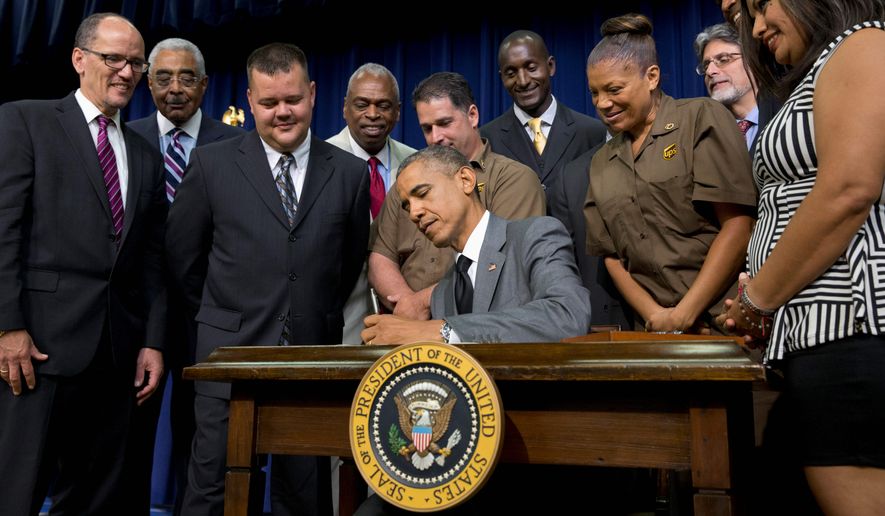President Obama will set a record for the size of the basic federal workforce, leaving office with more than 1.4 million people collecting government salaries in the civilian agencies in 2017, according to the budget he delivered to Congress on Tuesday.
It’s a 10 percent jump from the time he took office in 2009 but less than the 17 percent hike under his Republican predecessor, President George W. Bush.
Republicans and Democrats have reversed gains made under Presidents Reagan and Clinton.
Mr. Obama also managed to limit the growth of government salaries and curb civilian pay hikes far more than Mr. Bush did, which earned him slight praise from government watchdogs.
“Obama gets credit for his three-year partial freeze of federal worker pay. It did slow wage growth,” said Chris Edwards, director of tax policy at the Cato Institute and editor of DownsizingGovernment.org.
But Mr. Edwards said Mr. Obama reversed the trend of Mr. Clinton, who cut government in part by outsourcing the work of federal employees and hiring contractors to do their jobs. “Obama has worked hard to insource them again, as his union allies have pushed for,” Mr. Edwards said.
Mr. Obama’s top advisers said they wish they were able to hire even more workers in key agencies, particularly at the Department of Veterans Affairs and the IRS.
The IRS was able to answer only about 40 percent of calls from taxpayers last year and left them on hold for an average of about a half-hour.
“There are clearly places where we do need more workers,” Shaun Donovan, director of the White House Office of Management and Budget, told reporters.
The biggest labor union for federal workers, the American Federation of Government Employees, is pushing for pay increases of about 5.3 percent this year.
“We are sick and tired of pay freezes and pathetic penny ante raises. We are sick and tired of falling behind inflation and further behind private-sector pay,” said AFGE President J. David Cox Sr. “We’re not asking for any special treatment, just the pay increases we are owed after six years of low to no pay increases.”
Overall, as he prepares to close out his time in office, Mr. Obama has not lived up to the vision he had when he came into the White House in 2009. The economy is significantly weaker and debt has piled higher than he predicted in his first budget. But spending is down, held in check by deep discretionary cuts imposed by the president and congressional Republicans in 2011.
At this point, Mr. Obama expected to be raking in $4 trillion in tax revenue and spending $4.7 trillion. Instead, he is likely to collect about $3.5 trillion and spend $4.1 trillion, with Congress rejecting his latest tax-and-spending hikes.
But the size of the federal civilian agency workforce has grown in recent years regardless of who occupies the White House.
Paul C. Light, a professor public service at New York University and one of the country’s foremost analysts on the size of government, said the 2.1 million total civilian workforce — including those at the Pentagon — has been relatively static for years.
“That’s pretty much what presidents get. They go too much more, say 2.5 million, they’re going to get hammered,” Mr. Light said.
Mr. Clinton reduced the number to fewer than 2 million because the end of the Cold War allowed him to cut civilian jobs at the Pentagon.
But Mr. Bush and Mr. Obama have overseen increases.
In Mr. Obama’s case, the biggest leap was in the VA, which went from 272,000 in 2009 to a projected 367,000 in 2017. Homeland Security, the Justice Department and social services agencies also increased their numbers, but not enough to stir trouble with the public, Mr. Light said.
“He kind of gets a bye on it. It’s not a big enough increase to really break a ceiling, and it’s not much to criticize,” he said.
The size of the federal workforce has been a small issue in the current presidential campaign. Former Florida Gov. Jeb Bush has vowed to cut through attrition, hiring only one federal worker for every three who retire, and he and his fellow governors in the Republican field argue about success in managing their state employees, but the general size of government has not been a major point of debate.
• Stephen Dinan can be reached at sdinan@washingtontimes.com.




Please read our comment policy before commenting.